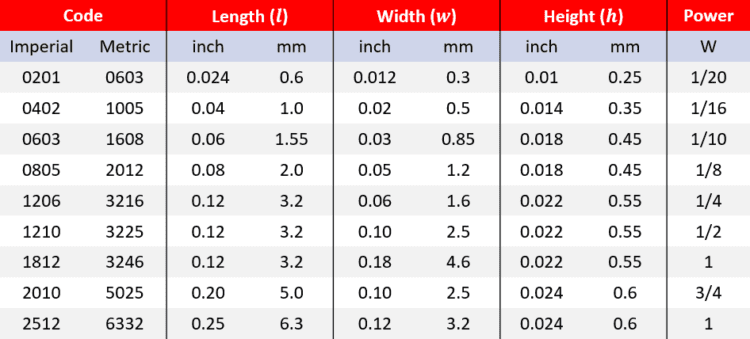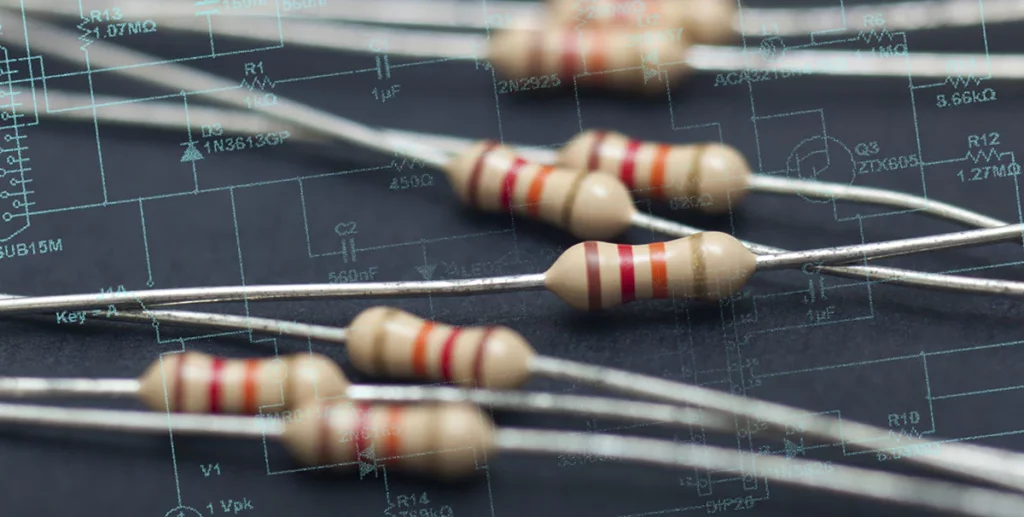This post contains a quick guide to resistor sizes and packages. There is a wide range of package styles and sizes available for resistors. Today, the most common resistor type is the rectangular surface mount (SMD) resistor, though axial resistors are still widely used in through-hole designs as well.
To provide you with a comprehensive view of resistors, Linquip provides you with a great deal of information. Our “Electrical” page provides more information on Linquip’s solutions for your situation. Make your job easier by learning about different types of resistors right now.
Choosing the right resistor size may be difficult for you. Linquip offers a wide selection of Electrical Products, so you can find the one that fits your needs. Through the Linquip Platform, you will be able to receive free quotes from multiple Electrical Suppliers and Companies in this industry.
In this post, dimensional information for SMD, axial, and MELF packages is provided. A few recommended land patterns are given below for attaching SMD components to PCBs via solder.
A Brief Introduction to Resistors
In a circuit, the resistor restricts the flow of electrons. The electrical resistance of a resistor is constant and does not change over time.
They consume power (and cannot generate it), so they are passive components. An integrated circuit usually includes resistors as a complement to active components such as op-amps, microcontrollers, and other components. The most common uses of resistors are limiting current, dividing voltages, and pulling I/O lines up.
The electrical resistance can be measured in ohms. Ohms are represented as Greek capital omegas: Ω. 1Ω is defined as the resistance between two spots where 1 volt of potential energy pushes one amp of current.
A prefix like a kilo-, mega-, or giga- can be applied to larger or smaller values of ohms to make reading large values easier.
On each end of every resistor, there are two terminals. A resistor’s terminals are lines extending from its squiggle (or rectangle). These are the connections to the rest of the circuit. You can see the symbol for a resistor in a circuit in the following figure.

SMD Resistor
A surface-mount resistor comes in the form of a tiny black rectangle, both ends terminating with small, shiny, silver, conductive edges. They are intended to be soldered to mating landing pads on PCBs. Due to their small size, these resistors are usually assembled by robots and then heated to melt the solder which secures them.
Size
Most manufacturers use the JEDEC standards to standardize the shape and size of surface mount resistors. Numerical codes such as 0603 indicate the size of SMD resistors. A package’s length and width are contained in this code. Thus, 0603 indicates 0.060″ of length and 0.030″ of width.
Both imperial and metric units are available for SMD package codes. Imperial codes are more often used to indicate package sizes in general. The printed circuit boards (PCBs) are often designed using metric dimensions, even when the imperial naming convention is used. Generally, you can assume that the code uses imperial units, but the measurements are in millimeters.
Power ratings, PCB feature sizes, and pick-and-place equipment limitations determine the size of SMD resistors to use.
In the following table, you will find a list of common surface mount packages with their dimensions and specifications.

MELF Resistor
A metal electrode leadless face (MELF) is another kind of surface mount resistor package. MELF packages have lower thermal coefficients and are more stable than standard SMD packages. Typical thin film MELF resistors have a temperature coefficient of resistance (TCR) ranging from 25 to 50 ppm/K, in contrast to standard thick film SMD resistors with TCR above 200 ppm/K. MELF resistors have a lower TCR due to their cylindrical design.
Also, the cylindrical construction of the package has some disadvantages, especially when pick-and-place machines are used to place the components. Having a round shape requires special suction cups and more vacuum.
Size
The three most common sizes of MELF packages are MicroMELF, MiniMELF, and MELF. These types are described in the following table.

THT Resistor
Through-hole resistors feature lengthy, pliable leads that can be glued to a breadboard or soldered to a prototype board or printed circuit board (PCB). In general, these resistors are more useful for bread boarding, prototyping, or whenever you don’t want to solder tiny, 0.6mm-long SMD resistors. As a result of their long leads, these resistors usually require trimming, and compared with surface-mount devices, they occupy much more space.
Two general types of terminations are available for Through-Hole Technology (THT) components:
- Axial: the leads are located on both sides of the component
- Radial: the leads are located on one end (same side).
THT Axial Resistor
An axial package is the most common configuration for through-hole resistors. The THT axial resistor has two leads protruding from its body on either side. Adapted leads (or customer requests) are shaped before being inserted into holes and soldered on the other end. When the THT resistor is soldered, excess lead length is trimmed on the opposite end if necessary.

THT Radial Resistor
Two leads protrude from the same side of the body of THT radial resistors. The component is usually mounted vertically on the PCB so that it is upright or perpendicular to the board. In comparison to their axial counterparts, these typically occupy relatively less space, making them ideal for projects with tight footprint spacing.
Size
As opposed to SMD resistors, THT resistors are not standardized, and manufacturers may use slightly different measurements. THT resistors are also sized based on their power ratings and their type, e.g. carbon material, wire-wound, carbon film, and metal film. For example, the width of a common 1/2W resistor is 9.2mm, while the length of a smaller 1/4W resistor is 6.3mm. Make sure you check the manufacturer’s datasheet whenever you need to know a component’s exact size.
Special Resistor Packages
The market also offers a variety of other special-purpose resistors. It is possible to buy pre-wired of five or so resistor packages. These arrays may contain resistors that share a common pin or are configured as voltage dividers.
Power Rating
Power ratings are one of the hidden values in resistors. The topic will come up when choosing a resistor type, however, and it can be quite important.
Power refers to the rate at which energy transforms from one thing to another. Multiplying the voltage difference between two points by the current flowing between them yields watts (W). A light bulb, for example, converts electricity into light. However, a resistor can only convert electrical energy into heat. Electronics aren’t really friends with heat; too much heat causes smoke, sparks, and fire!
There is a maximum power rating for every resistor. It is important to keep the power across a resistor under its maximum rating to prevent it from overheating. Power ratings for resistors are measured in watts, and they typically range between 1/8W and 1W. Power resistors are used specifically for dissipating power and have power ratings greater than 1W.
It is usually possible to determine a resistor’s power rating by looking at its package. There are usually 1/4W or 1/2W ratings on standard through-hole resistors. Power resistors might even include their power rating on the resistor if they are used for a specific purpose.
Resistor Selection
A resistor should be selected based on the following steps:
- Calculate the resistance.
- Calculate the Watts that the resistor will dissipate.
- The “Watt Size” should be determined by taking into account factors such as wattage, voltage, operating temperature, mounting conditions, and circuit setup.
- Choose the right type, terminals, and mounting for the unit.
FAQs
What is an SMD resistor package?
The use of SMD resistors provides significant benefits in terms of space savings and automated production of printed circuit boards. It allows for further miniaturization and functionality to be packed into the same space, saving board space.
What are the sizes of THT resistors?
An axial package is the most common package for through-hole resistors. Axial resistors are sized according to their power rating. It’s common to find 1/2W resistors measuring 9.2mm across and 1/4W resistors measuring 6.3mm.
Is it possible to replace an SMD resistor with a normal resistor?
Yes. Use a resistor that has a power rating equal to or greater than that of the SMD part (this should be easy to do), bend the leads onto solder pads, and solder into position after the SMD part is removed.
Conclusion
This article is aimed at providing you with the key points about resistor packages and sizes. In this regard, we discussed the basic characteristics of SMD and THT resistor packages. Linquip Electrical Experts are available to answer all your questions about selecting the right resistor for your particular application. Moreover, the Linquip platform also provides you with access to a variety of Electrical Service Providers if you need any services regarding your equipment and electrical devices.
Download PDF for Guide to Resistor Sizes and Packages
You can download the PDF format of this post from the link provided here.
Buy Equipment or Ask for a Service
By using Linquip RFQ Service, you can expect to receive quotations from various suppliers across multiple industries and regions.
Click Here to Request a Quotation From Suppliers and Service Providers
Read More on Linquip
- Variable Resistor∶ Learn The Basics, Get The Most out of It!
- Mastering Resistance Calculations: A Comprehensive Guide for Electrical Enthusiasts
- All You Need to Know About Guide to Resistor Values
- A Quick Guide to Resistor Color Code
- What is Braking Resistor? (A Practical Guide)
- What Are Resistors for LED Circuits? (Clear Guide)
- Everything You Need to Know About Variable Resistor Function
- Variable Resistor Symbol։ Everything You Need to Know
- Types of Resistor: Classification, Application, and Finally Clarification
- What is Shunt Resistor? + Function & Applications
- What is Pull-up and Pull-down Resistors? + Typical Application



